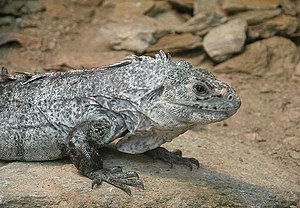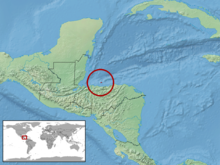Utila iguana
| Utila iguana | ||||||||||||
|---|---|---|---|---|---|---|---|---|---|---|---|---|

Utila iguana ( Ctenosaura bakeri ) |
||||||||||||
| Systematics | ||||||||||||
|
||||||||||||
| Scientific name | ||||||||||||
| Ctenosaura bakeri | ||||||||||||
| Stejneger , 1901 |
The Utila Iguana ( Ctenosaura bakeri ) is an unusual representative of ctenosaura whose distribution on to Honduras belonging Caribbean island of Utila ( Bay Islands is limited).
description
The German name black iguana refers to the gray-brown to black color that is common to all black iguanas to varying degrees. Utila iguanas are the only black iguanas that are clearly gray-brown to black in color when they hatch when they are young; Young animals of other species initially have a green color.
Males reach a length of up to 76 cm, females up to 56 cm.
ecology
According to current knowledge, the Utila iguana occurs endemically in the approximately 10 km² mangrove forest on the Honduran Caribbean island of Utila . He is a resident of the canopy and lives in tree hollows or hollow trunks. The adaptation to the salty and humid habitat of the mangrove is a specialty of this species, all other black iguanas prefer arid habitats.
The iguanas are omnivorous and feed on leaves, crabs and insects.
Reproduction
Since the clutch of the Utila iguana would not hatch successfully in the moist mangrove forests, the pregnant females migrate to sunny sandy beaches in the vicinity of the mangrove at the beginning of the dry season. However, there are only a few sandy stretches of beach on Utila. In March, the females dig deep burrows in the sand and lay 5 to 15 eggs. Compared to other types of iguana, these are rather few. After laying eggs, the females retreat back into the mangrove forest. Around 90 days later, the young hatch and initially migrate to the bushy mangrove edge areas.
The young animals are endangered by predators such as crabs, snakes, birds and large conspecifics. Only 5% survive the first year. In addition, the iguana's eggs are considered a delicacy on the island and are often dug up. Pregnant females were also caught on the beach and killed to get the eggs. This almost led to the extinction of the Utila iguanas at the end of the 20th century.
Discovery story
Ctenosaura bakeri was described in 1901 on the basis of animals that the Washington Zoo had received from the US Consul on Utila. They were females caught on the island's beaches. After her death, the zoo director Frank Baker , after whom the species was named, made it available to the herpetologist Leonhard Hess Stejneger for systematic investigations.
At first nothing was known about the unusual ecological niche and it was assumed that the iguanas would live in the beach area of Utilas. The species was thought to be lost until the mid-1990s. It was not until 1994 that Gunther Köhler examined the systematics of black iguanas as a doctoral student at the Johann Wolfgang Goethe University in Frankfurt am Main ; Almost by chance he came across an adult male Utila iguana in the mangrove.
Hazard and protection
While scientists had searched in vain for the species for nearly a hundred years, the Utila iguana, known as the swamper, had long been on the island's menu. Constant immigration, due to the tourism boom on the Islas de la Bahía , to which Utila belongs, had increased the hunting pressure on the species. On the initiative of Koehler and other scientists, the Utila iguana was placed under nature protection under Honduran law in 1994. Since the end of 2004 the species has also been classified as “critically endangered” on the Red List of Threatened Species of the World Conservation Union .
A joint species protection project of the Senckenberg Society for Nature Research and the Frankfurt Zoological Society has been running a station on Utila since 1997, which is dedicated to educating and advising the population and tourists and runs a rearing program. Utila iguanas were also bred in the Frankfurt Zoo . The work in the station on Utila is carried out exclusively by volunteers from all over the world; the station is operated with donations.
Web links
- Ctenosaura bakeri in The Reptile Database
- Ctenosaura bakeri inthe IUCN 2011 Red List of Threatened Species 5.4. Posted by: Pasachnik, S., Martinez, A. & Perez, MS, 2011. Retrieved February 10, 2016.
